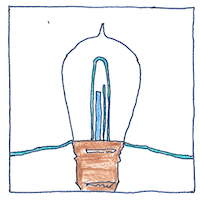Frederick Guthrie,
Thomas Edison
electromagnetism

|
Thermionic emission
Heating a cathode frees electrons, which flow through a vacuum to an anode with a positive charge but which do not flow to an anode with a negative charge even if you provide to the cathode new electrons from a battery. Today this is called thermal electron emission. At the time, the electron had not been discovered. They knew the hot cathode emitted something, so they called it a thermion.
.On a Relation between Heat and Static Electricity
Frederick Guthrie’s experiments in 1873 tested how a hot cast-iron ball carried positive or negative static electrical charges and discovered the ball would not carry a positive charge when it was hot and the ball would carry a negative charge only when it was hot.
Edison effect
In 1880, Thomas Edison, or William Joseph Hammer, Edison’s assistant when developing the light bulb, added a lead to a metal foil in a few light bulbs to see why the inside of light bulbs blackened near the positive terminal of the hot filament, and found that a current flowed from the filament when the added foil had a positive charge but not when it had a negative charge.
Schottky effect
The emission of electrons from a hot surface is increased by applying an electric field to hold a negative electric charge at the surface.
Thermion dance
A metallic surface in a vacuum is half metal, half vacuum, and dancing dancing on that surface, dance thermions. When the surface gets too hot thermions cannot stay on, and so they slip, they slip into the vacuum like dust motes. Thermions slip like drops of mist, float into space, drift like helpless mosquitoes, and fly like tiny moths attracted to a lamp.



The work function of a surface is the energy that an electron needs to escape into space. For a metal, this energy varies for different arrangements of atoms on crystal faces. Once an electron is free, it can be accelerated by an electric field toward the anode of a vacuum tube.
John Ambrose Fleming created the first thermionic vacuum tube, the Fleming valve. Guthrie was a mentor to Fleming but Fleming was more inspired by the Edison effect embodied in vacuum tubes.
See also in The book of science:
Readings in wikipedia:
Other readings: